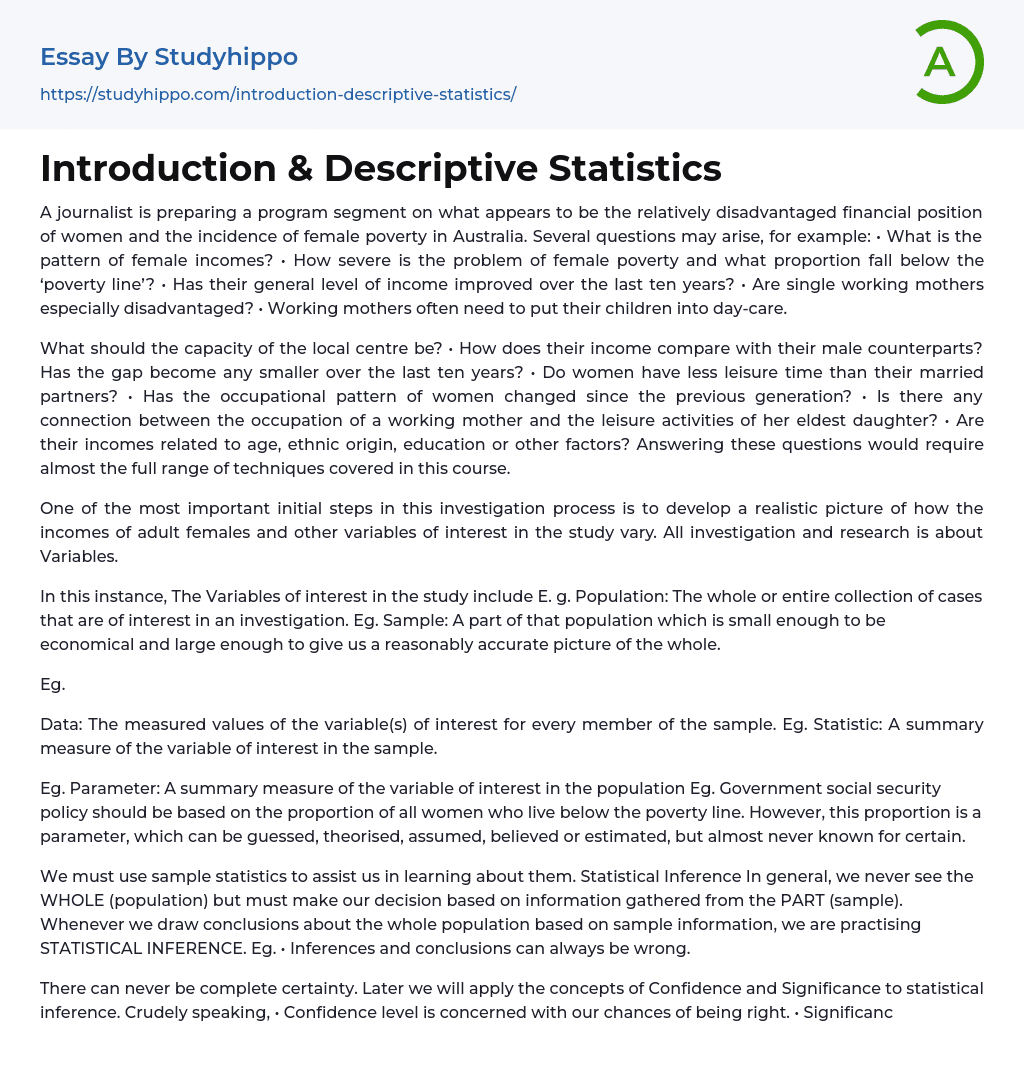A journalist is preparing a program segment on what appears to be the relatively disadvantaged financial position of women and the incidence of female poverty in Australia. Several questions may arise, for example: • What is the pattern of female incomes? • How severe is the problem of female poverty and what proportion fall below the ‘poverty line’? • Has their general level of income improved over the last ten years? • Are single working mothers especially disadvantaged? • Working mothers often need to put their children into day-care.
What should the capacity of the local centre be? • How does their income compare with their male counterparts? Has the gap become any smaller over the last ten years? • Do women have less leisure time than their married partners? • Has the occupational pattern of
...women changed since the previous generation? • Is there any connection between the occupation of a working mother and the leisure activities of her eldest daughter? • Are their incomes related to age, ethnic origin, education or other factors? Answering these questions would require almost the full range of techniques covered in this course.
One of the most important initial steps in this investigation process is to develop a realistic picture of how the incomes of adult females and other variables of interest in the study vary. All investigation and research is about Variables.
In this instance, The Variables of interest in the study include E. g. Population: The whole or entire collection of cases that are of interest in an investigation. Eg. Sample: A part of that population which is small enough to be economical and large
enough to give us a reasonably accurate picture of the whole.
Eg.
Data: The measured values of the variable(s) of interest for every member of the sample. Eg. Statistic: A summary measure of the variable of interest in the sample.
Eg. Parameter: A summary measure of the variable of interest in the population Eg. Government social security policy should be based on the proportion of all women who live below the poverty line. However, this proportion is a parameter, which can be guessed, theorised, assumed, believed or estimated, but almost never known for certain.
We must use sample statistics to assist us in learning about them. Statistical Inference In general, we never see the WHOLE (population) but must make our decision based on information gathered from the PART (sample). Whenever we draw conclusions about the whole population based on sample information, we are practising STATISTICAL INFERENCE. Eg. • Inferences and conclusions can always be wrong.
There can never be complete certainty. Later we will apply the concepts of Confidence and Significance to statistical inference. Crudely speaking, • Confidence level is concerned with our chances of being right. • Significance level is concerned with our chances of being wrong.
- Overpopulation essays
- Homelessness essays
- Hunger essays
- Dumpster Diving essays
- Homelessness In America essays
- Research Methods essays
- Experiment essays
- Hypothesis essays
- Observation essays
- Qualitative Research essays
- Theory essays
- Explorer essays
- Normal Distribution essays
- Probability Theory essays
- Variance essays
- Abortion essays
- Abuse essays
- Animal Rights essays
- Animal Testing essays
- Assault essays
- Bullying essays
- Controversial Issue essays
- Crash essays
- Cyber Bullying essays
- Feminism essays
- Human Rights essays
- Immigration essays
- Inequality essays
- Poverty essays
- Prejudice essays
- Racism essays
- Torture essays
- Violence essays
- Agriculture essays
- Albert einstein essays
- Animals essays
- Archaeology essays
- Bear essays
- Biology essays
- Birds essays
- Butterfly essays
- Cat essays
- Charles Darwin essays
- Chemistry essays
- Dinosaur essays
- Discovery essays
- Dolphin essays
- Elephant essays
- Eli Whitney essays
- Environmental Science essays




